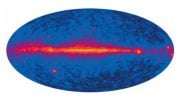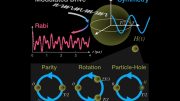
A team at UPV’s Nanophotonics Technology Center has discovered a new fundamental symmetry in electromagnetism, acoustics, and elasticity laws: a temporal supersymmetry. Credit: UPV
A team at UPV’s Nanophotonics Technology Center has discovered a new fundamental symmetry in electromagnetism, acoustics and elasticity laws: a temporal supersymmetry.
According to Carlos García Meca and Andrés Macho Ortiz, researchers at NTC-UPV, this new symmetry allows the conservation of the linear moment between dramatically different physical systems. This paves the way for designing pioneering optical, acoustic, and elastic devices, including invisible omnidirectional, polarization-independent materials, ultra-compact frequency shifters, isolators, and pulse-shape transformers.
“These devices allow us to unusually modify different properties of light signals inside photonic circuits to process the spread of information. This is vital in communication systems. Moreover, we can adapt the functionality of those devices to the requirements at any time, as they are dynamically configurable,” explained Carlos García Meca.
For designing these new devices, the key lies in changing the refraction index, which in this case is not generated in space but in time. “The Supersymmetry technique tells us how to vary the refraction index of an object to have the light completely transmitted, avoiding undesired reflections,” said Andrés Macho Ortiz.
The property of non-reflection is particularly useful for designing new photonic circuits. “Its implementation allows us to increase the speed of communications inside and makes them more compact and configurable without the signal that transports information bits being reflected back,” explained Carlos and Andrés.
In general, the reflection of materials whose properties vary in time does not depend on the direction of light propagation. Therefore, “the absence of reflection in the proposed materials is linked to a total transparency, which results in the concept of omnidirectional invisibility: whatever the direction of light hitting those materials is, their presence is undetectable,” concluded the authors.
Symmetries
The discovery of symmetries in nature is a cornerstone in physics that allows us to find the conservation laws governing the universe. For example, electric charge, energy, and mass conservation (coming from symmetries in physical laws governing electromagnetism, thermodynamics, and chemistry) has allowed humans to have the ability to develop this technology (circuits, nuclear power stations, drugs…).
Exceptionally, supersymmetry was originally conceived in quantum physics as a hypothetical symmetry between particles that could explain all interactions in nature: nuclear forces, gravity, and electromagnetism.
Reference: “Supersymmetry in the time domain and its applications in optics” by Carlos García-Meca, Andrés Macho Ortiz and Roberto Llorente Sáez, 10 February 2020, Nature Communications.
DOI: 10.1038/s41467-020-14634-0









This article presents a nice way to use supersymmetry for certain device development, but the overall understanding of how, for example, light can be both a particle and a wave, remains unsolved. One approach, suggested by a view of String Theory, is shown in the YouTube, “Supersymmetry – A String Theory Way” at https://www.youtube.com/watch?v=57_42RbiaB0